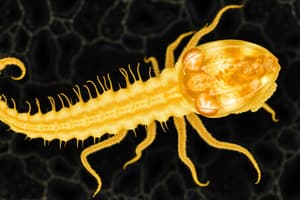Podcast
Questions and Answers
What is the fundamental principle of biology?
What is the fundamental principle of biology?
- Cell theory
- Genetics
- Homeostasis
- Evolution (correct)
Evolution is a process that results in organisms becoming identical over time.
Evolution is a process that results in organisms becoming identical over time.
False (B)
What are the five unifying themes used by biologists to make sense of life's diversity and complexity?
What are the five unifying themes used by biologists to make sense of life's diversity and complexity?
Organization, information, energy and matter, interactions, evolution
Nothing in biology makes sense except in the light of __________.
Nothing in biology makes sense except in the light of __________.
Match the unifying themes of biology with their descriptions:
Match the unifying themes of biology with their descriptions:
Which of the following best describes evolution?
Which of the following best describes evolution?
Biologists only have questions focused on cellular processes.
Biologists only have questions focused on cellular processes.
What does the study of biology encompass?
What does the study of biology encompass?
What does the approach of reductionism focus on?
What does the approach of reductionism focus on?
Emergent properties are unique to life and do not appear at simpler levels of biological organization.
Emergent properties are unique to life and do not appear at simpler levels of biological organization.
What is systems biology?
What is systems biology?
The leaf's broad, flat shape maximizes light ________.
The leaf's broad, flat shape maximizes light ________.
Match the following concepts with their descriptions:
Match the following concepts with their descriptions:
Which level of biological organization allows for novel properties to emerge?
Which level of biological organization allows for novel properties to emerge?
The anatomy of a hummingbird allows it to only hover in place and not fly backward.
The anatomy of a hummingbird allows it to only hover in place and not fly backward.
The approach that guides an incomplete view of life is known as _________.
The approach that guides an incomplete view of life is known as _________.
What are the two chains in a DNA molecule called?
What are the two chains in a DNA molecule called?
Energy and matter are essential for life because they enable organisms to interact with physical factors in their environment.
Energy and matter are essential for life because they enable organisms to interact with physical factors in their environment.
What is the primary function of photosynthetic organisms in an ecosystem?
What is the primary function of photosynthetic organisms in an ecosystem?
DNA encodes information in a manner analogous to how we arrange letters into _____ and phrases with specific meanings.
DNA encodes information in a manner analogous to how we arrange letters into _____ and phrases with specific meanings.
Match the following interactions with their effects:
Match the following interactions with their effects:
Which of the following factors does not interact with organisms in an ecosystem?
Which of the following factors does not interact with organisms in an ecosystem?
All interactions within an ecosystem are mutually beneficial.
All interactions within an ecosystem are mutually beneficial.
What causes a decrease in a lizard's reproductive success?
What causes a decrease in a lizard's reproductive success?
What is the smallest unit of organization that can perform all activities required for life?
What is the smallest unit of organization that can perform all activities required for life?
All cells share certain characteristics and can be distinctly classified into prokaryotic and eukaryotic cells.
All cells share certain characteristics and can be distinctly classified into prokaryotic and eukaryotic cells.
What genetic material do chromosomes contain?
What genetic material do chromosomes contain?
Each chromosome contains a very long ______ with many genes.
Each chromosome contains a very long ______ with many genes.
Match the following terms to their corresponding definitions:
Match the following terms to their corresponding definitions:
During cell division, what is transmitted to the daughter cells?
During cell division, what is transmitted to the daughter cells?
Genetic information encoded by DNA does not influence development.
Genetic information encoded by DNA does not influence development.
You began as a single cell stocked with DNA inherited from your ______.
You began as a single cell stocked with DNA inherited from your ______.
Study Notes
Adaptations and Evolution
- Organism adaptations arise from evolution, a process of change over time leading to Earth's diverse life forms.
- Evolution is the fundamental principle of biology; nothing in biology makes sense without it (Dobzhansky).
- Scientific inquiry involves posing questions about life and seeking answers through research.
Scope of Biology
- Biology encompasses a wide scope, from cellular functions to complex ecosystems.
- Questions in biology can be ambitious, exploring transitions from single cells to complex organisms like trees and dogs.
Unifying Themes in Biology
- Life's diversity is understood through five unifying themes:
- Organization
- Information
- Energy and matter
- Interactions
- Evolution
Organization in Biology
- Life exists across several organizational levels, from molecules to entire ecosystems, illustrated by biological hierarchy.
- Reductionism simplifies complex systems to easier components for study; however, this method provides an incomplete view of life.
- Emergent properties arise at each organizational level due to the arrangement and interactions of parts, relevant to both living and non-living systems.
- Systems biology complements reductionism by exploring networks of interactions that contribute to life’s emergent properties.
Structure and Function
- There is a correlation between structure and function at each biological organization level.
- Example: The broad, flat shape of leaves enhances light capture; the specialized anatomy of hummingbirds allows unique flight maneuvers.
- Analyzing biological structures reveals clues about their roles and operations.
Cells as the Unit of Life
- Cells are the smallest units capable of performing life activities. All cells share certain characteristics but fall into two categories:
- Prokaryotic: Simple, lacking membrane-bound organelles.
- Eukaryotic: Complex, with defined structures enclosed by membranes.
Information Storage and DNA
- Genetic material is housed in chromosomes made up of DNA (deoxyribonucleic acid).
- Each chromosome contains a long DNA molecule composed of numerous genes, essential for building cellular molecules and transmitting heredity from parents.
- DNA's molecular structure enables information storage through nucleotide sequences that encode necessary biological information, similar to language composition.
Energy and Matter in Life
- Life requires the transfer and transformation of energy and matter for movement, growth, reproduction, and cellular activities.
- Work (e.g., growth and reproduction) relies on energy input.
Interactions in Ecosystems
- Organisms interact continuously with others and their physical environment in ecosystems.
- Interactions can be mutualistic or harmful; for instance, photosynthetic organisms provide oxygen, benefiting humans and other species.
- Ecosystems display various interactions, such as predator-prey dynamics and environmental adaptations impacting feeding and reproduction.
Evolution as Biology's Core Theme
- Evolution is integral to understanding biological principles and themes, reinforcing all aspects of life’s diversity and interactions.
Studying That Suits You
Use AI to generate personalized quizzes and flashcards to suit your learning preferences.
Related Documents
Description
Explore the fundamental principles of biology, focusing on how adaptations arise from the evolutionary process. Dive into the unifying themes that help us understand life's diversity, from cellular functions to complex ecosystems. This quiz will test your knowledge on various organizational levels and the connections between life forms.




